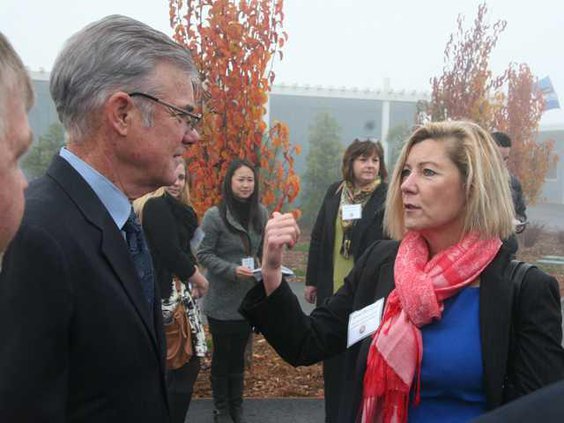Tom Torlakson is impressed with River Islands Technology Academy.
So impressed that the man who oversees 10,000 public schools and the education of 6 million students as California’s State Superintendent of Public Instruction made his second visit in three years to the Lathrop charter school.
The infusion of cutting edge technology to advance science, technology, engineering, and math education first lured Torlakson to visit in 2013.
He was impressed.
But what brought him back Monday — and what he saw — managed to impress him even more.
Test scores of River Islands students are among the highest in the region with 24 percent exceeding state standards for English compared 16 percent statewide. In addition another 25 percent met state standards for English. The connection with students helps explain a high attendance rate of 98.5 percent. It is also why there is a waiting list of 500 students seeking to secure a coveted spot at the charter school.
And it wasn’t just what was going on in the classrooms. It was the classroom and campus itself.
“You are among the top of (California’s) 6 million students,” Torlakson told the 550 students surrounding an outdoor stage on a fog-shrouded morning.
But Torlakson saw nothing but brightness on the horizon.
It started when he was serenaded by a classic student musical group after arriving at the charter school being housed temporarily on land that one day will serve as a teeming town square for the San Joaquin Valley’s largest planned community. It was enhanced as he observed fourth graders producing i-Movies showcasing various projects and others experimenting with robotics in one classroom. The enthusiasm of hands-on learning where primary students were using shaving cream floating on pans of water while employing blue food dye to get a hands-on grasp of the concept of rain re-enforced it. And the use of touch-screen projector whiteboards to engage students using tablets in everything from reading to math cemented his observations.
“The technology we have today is even more advance than it was two years ago when you first visited,” noted River Islands Technology Academy board member Susan Dell’Osso who is also the project manager for the 10,800-home River Islands planned community.
And the reason even more advanced technology came into being is what brought Torlakson back for a second visit.
Nine months ago River Islands was told it was about to become a school with no home. Banta School District that took a $12 million check from River Islands principal Alan Chapman and wedded it with $12 million in state school bonds to build the original campus to open as a charter school abruptly told the highly-acclaimed tech academy to get out so they could open their own STEM charter school.
What took place next made the Miracle on 34th Street pale in comparison.
Chapman bankrolled an $8 million solution that took just four months to go from bare ground to reality. And what materialized wasn’t a thrown together campus. It is even more cutting edge when it comes to technology — and certainly dollar efficient construction — than the original campus that is now just across the street.
It allowed 27 miles of Cat-6 wire to go in place to allow short throw projectors in every room. The 53,000 square feet of Department of State Architect approved classrooms were fashioned from portables secured from San Diego to Portland. There is also a 12,800-square-foot multipurpose room and 4,800-square-foot cafeteria. Four miles of drip irrigation as opposed to less efficient bubbler systems were put in place for 3,000 plants and shrubs as well as 220 trees. Bermuda grass that uses 20 percent less water than typical fescue was put in place.
One hundred percent non-potable water is used on all ballfields.
There is also LED lighting throughout.
Added touches such as 15,000 tons of subsurface rock made the classrooms flush with walkways while 400 6-foot by 6-foot posts were used to create a trellis look in front of classrooms to negate the visual portable.
And while it looks permanent it is all designed to be moved in five to 10 years when either a traditional permanent structure is in place or it would make sense to be relocated elsewhere when work starts on the town square. The multi-purpose room could eventually also be moved elsewhere and repurposed as a corporation yard building for River Islands.
It is the innovative thinking and partnerships such as what was essential between the City of Lathrop and River Islands that made the campus a reality in record time for a California school that got Torlakson’s attention.
“It is something we need to consider as California struggles to find money to build new schools,” Torlakson said of the “stick” approach used by River Islands.
The state superintendent noted that besides the reduced costs and shorter time from start to finished product, the River Islands approach allows flexibility as education needs change over the years. Reconfiguring “stick” construction or portables to adapt to changing classroom needs as technology changes can be done quicker and with less money than trying to retrofit traditional permanent classroom structures.
The seamless transition to the new campus plus the success of the charter school was reflected in the fact 100 percent of the students stayed with River Islands Technology Academy as did 100 percent of the faculty.
River Islands impresses top educator
State superintendent lauds charter schools success





